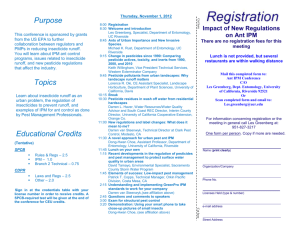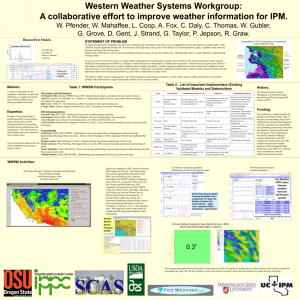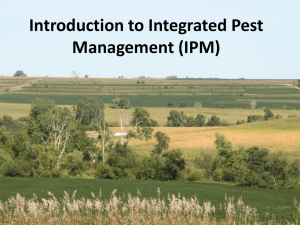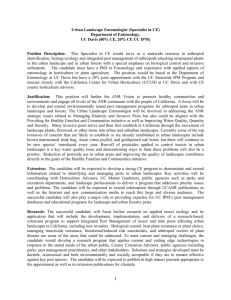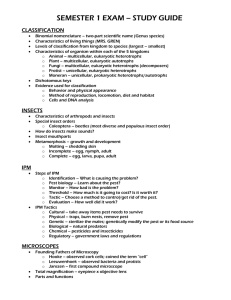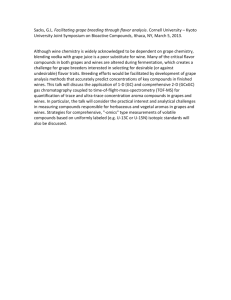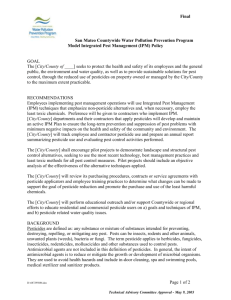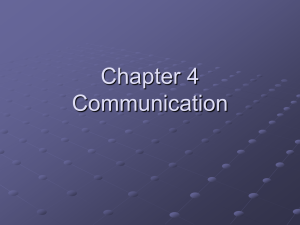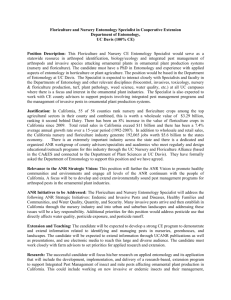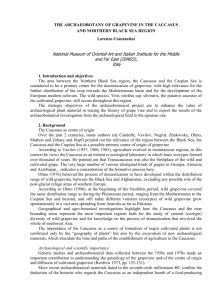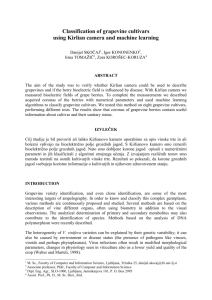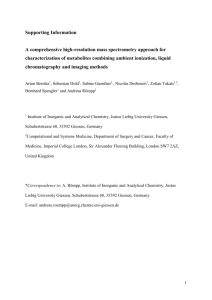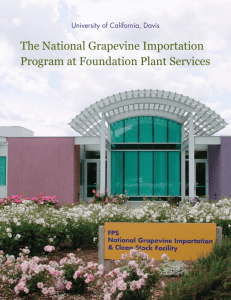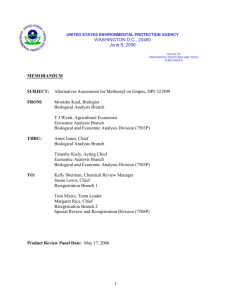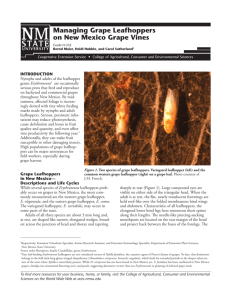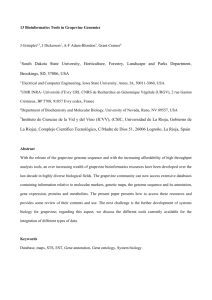Crop Diseases
advertisement
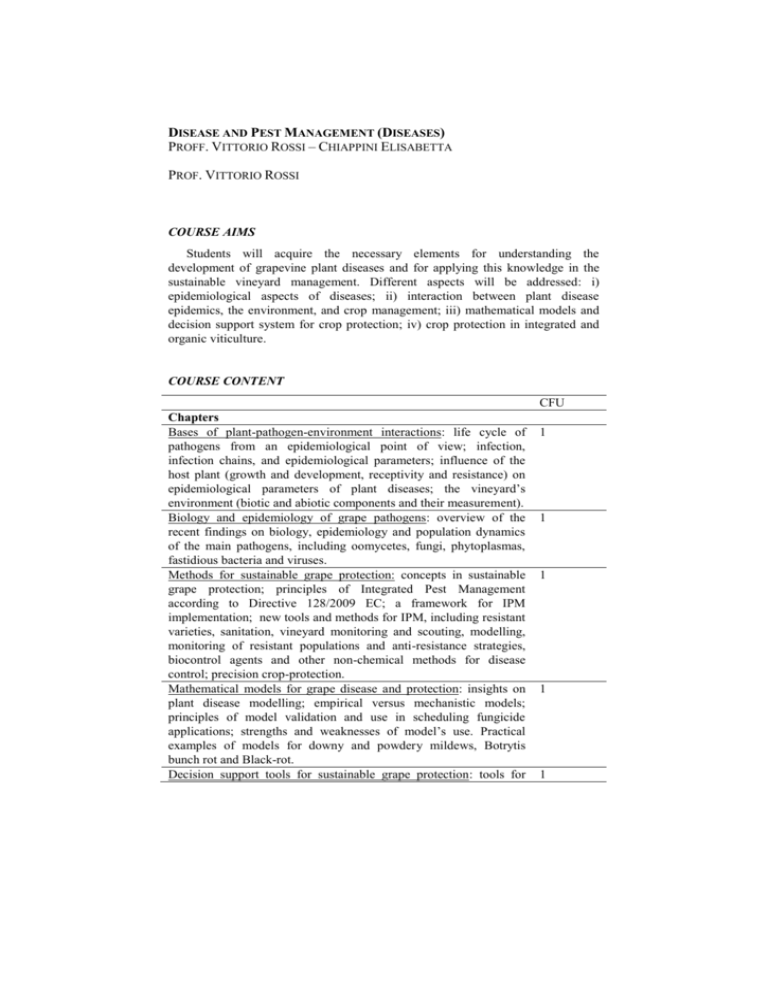
DISEASE AND PEST MANAGEMENT (DISEASES) PROFF. VITTORIO ROSSI – CHIAPPINI ELISABETTA PROF. VITTORIO ROSSI COURSE AIMS Students will acquire the necessary elements for understanding the development of grapevine plant diseases and for applying this knowledge in the sustainable vineyard management. Different aspects will be addressed: i) epidemiological aspects of diseases; ii) interaction between plant disease epidemics, the environment, and crop management; iii) mathematical models and decision support system for crop protection; iv) crop protection in integrated and organic viticulture. COURSE CONTENT CFU Chapters Bases of plant-pathogen-environment interactions: life cycle of pathogens from an epidemiological point of view; infection, infection chains, and epidemiological parameters; influence of the host plant (growth and development, receptivity and resistance) on epidemiological parameters of plant diseases; the vineyard’s environment (biotic and abiotic components and their measurement). Biology and epidemiology of grape pathogens: overview of the recent findings on biology, epidemiology and population dynamics of the main pathogens, including oomycetes, fungi, phytoplasmas, fastidious bacteria and viruses. Methods for sustainable grape protection: concepts in sustainable grape protection; principles of Integrated Pest Management according to Directive 128/2009 EC; a framework for IPM implementation; new tools and methods for IPM, including resistant varieties, sanitation, vineyard monitoring and scouting, modelling, monitoring of resistant populations and anti-resistance strategies, biocontrol agents and other non-chemical methods for disease control; precision crop-protection. Mathematical models for grape disease and protection: insights on plant disease modelling; empirical versus mechanistic models; principles of model validation and use in scheduling fungicide applications; strengths and weaknesses of model’s use. Practical examples of models for downy and powdery mildews, Botrytis bunch rot and Black-rot. Decision support tools for sustainable grape protection: tools for 1 1 1 1 1 supporting grape growers in practical implementation of IPM; onsite devices, warning systems, and decision support systems (DSSs); strengths and weaknesses of the different tools; the DSS vite.net as a successful case-study. READING LIST References and reading materials will be set during the course. TEACHING METHOD Lectures, tutorial sessions, seminars, technical visits. ASSESSMENT METHOD The test consists of two parts: - In the first part the student will have to give written answers to 30 questions in a maximum of 60 minutes; - In the second part the commission will assign a score from zero to one to each of the written replies given by the student, also in relation to specific questions designed to clarify the written answers provided by the student, to deepen specific topics and assess the capacity of reasoning and analysis on the course topics, as well as the properties of language and communication skills. Prof. Vittorio Rossi is available to meet with students after class at the Institute of Entomology and plant pathology. .- Disease and Pest Management (Mod. Entomology) PROF. ELISABETTA CHIAPPINI COURSE AIMS Students will acquire the basic elements of general entomology and defence, and learn about the most important grapes parasites, to gain an understanding of the best protection strategies, in particular considering integrated production and organic agriculture. COURSE CONTENT Bases of entomology. Arthropods: mites and insects. The meaning of pest morphology, anatomy, and physiology with regard to their mode of attack and vine damages. Development and ethology towards possible manipulation to achieve control. Taxonomy: old and new techniques for species identification and its importance for defense management. CFU 1 Grape pests. Notes on pests harmful to the grapevine (mites, nematodes, vertebrates). Orders, families and the principal vine insects species. Recent vine cultivation changes and their influence on endemic and recently introduced species. Biotic potential in relation to environmental conditions. Transmission of pathogens. Defence strategies. Grapevine agro-system and its possible balance in relation to pest infestations. Knowledge of biological, biotechnical, agronomic, physical, mechanical, and chemical control methods and their efficacy in relation with the environment and their contemporary use. Environmental impact of defense actions. What to consider for an IPM program which takes into account the needed protection actions against grapevine pests and diseases. Legally mandated crop protection actions. Monitoring methods and thresholds. European legislation and Italian regulations for the development of integrated farming systems. 1 1 3 READING LIST Reading lists will be provided during the course. TEACHING METHOD Lectures. ASSESSMENT METHOD Oral examination. The evaluation will consider the question comprehension and the pertinence of the answer to the question, the organization of the answer, the use and mastery of the scientific language, the proficiency in the subject, and the student ability to make use of the knowledge acquired. NOTES Students should register at the course on the Blackboard platform, and check it regularly for further information or updates. Prof. Elisabetta Chiappini will meet students after class at Di. Pro.Ve.S. - Defence Area - Section Entomology.

